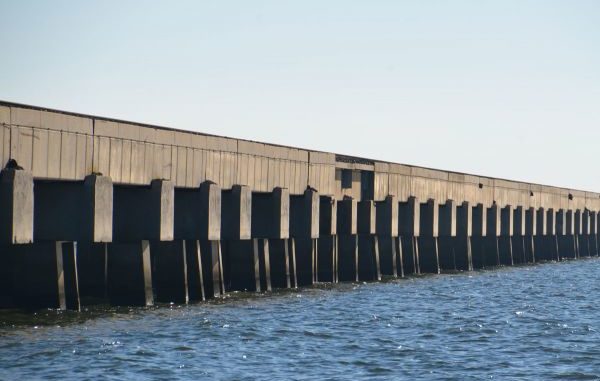
The bridge modern-day trout fishermen call the Trestles is old. In fact, nobody who fishes it today was alive when it was first built.
Officially called the Norfolk Southern Lake Pontchartrain Bridge, it was built in 1884 for the New Orleans and Northeastern Railroad. When William Harris Hardy, the railroad’s vice president proposed building it, many scoffed that it “couldn’t be built.”
The task seemed daunting. Not only would the 5.8 miles of open lake have to be spanned, but another 12 miles of marsh on the southern end and 3 more miles of marsh on the northern end would have to be bridged.
Twenty-one miles of bridge was a lot of bridge in those days.
But Hardy ignored the naysayers, and when the first passenger train crossed the bridge at 40 mph in November 1884, Hardy was onboard.
The first major modification to the bridge came in 1896. The spans of trestle — defined in the Merriam-Webster dictionary as “a structure of timbers or steel for supporting a road or railroad over a low place” — over the marsh at both ends were replaced with earthen embankments.
In 1916, the New Orleans and Northeastern Railroad became part of the Southern Railway System, formed in 1894 by combining nearly 150 smaller rail lines. In 1990, the railroad was renamed the Norfolk Southern Railway, which it remains today.
In 1961, the bridge was modified again with a feature that became important after Hurricane Katrina. Its short pieces of rail were replaced with welded rails, each a quarter of a mile long.
The last major change provided its modern appearance. The bridge was originally built of creosote-treated wooden pilings and timbers. Spaced periodically were small concrete segments called “fire breaks.”
The firebreaks were designed to prevent the entire bridge from burning down if one segment caught fire. With the latest change, all the wooden tressels were replaced by concrete.
None of these changes affected the bridge’s functionality. It carried as much or more rail traffic as before. Its single track is still today used daily by freight trains, as well as Amtrack’s Crescent passenger train twice a day.
The bridge is tough. Hurricane Katrina washed nearly 5 miles of track, cross ties and ballast off the bridge. Yet only two concrete spans were damaged beyond repair, and several were moved slightly.
Repair crews using nine cranes on barges were able to pick the welded rails from the lake bottom and put them back in place on the bridge. This was done in small increments, causing each crane barge to be moved over 400 times.
The decision to recover the tracks instead of rebuilding them saved a great deal of time, and — amazingly — just 16 days after Katrina devastated the area, the first train ran across the bridge.


